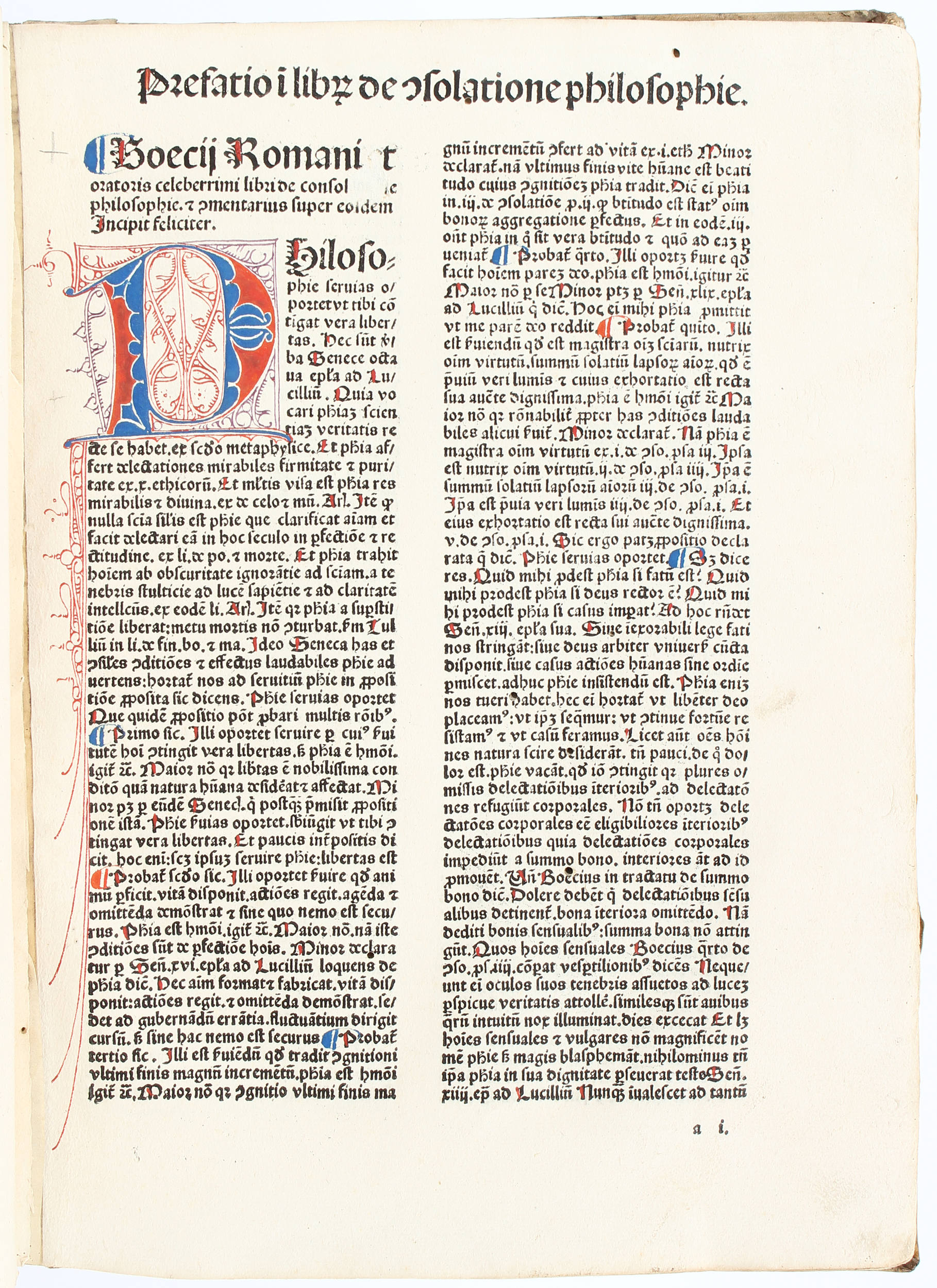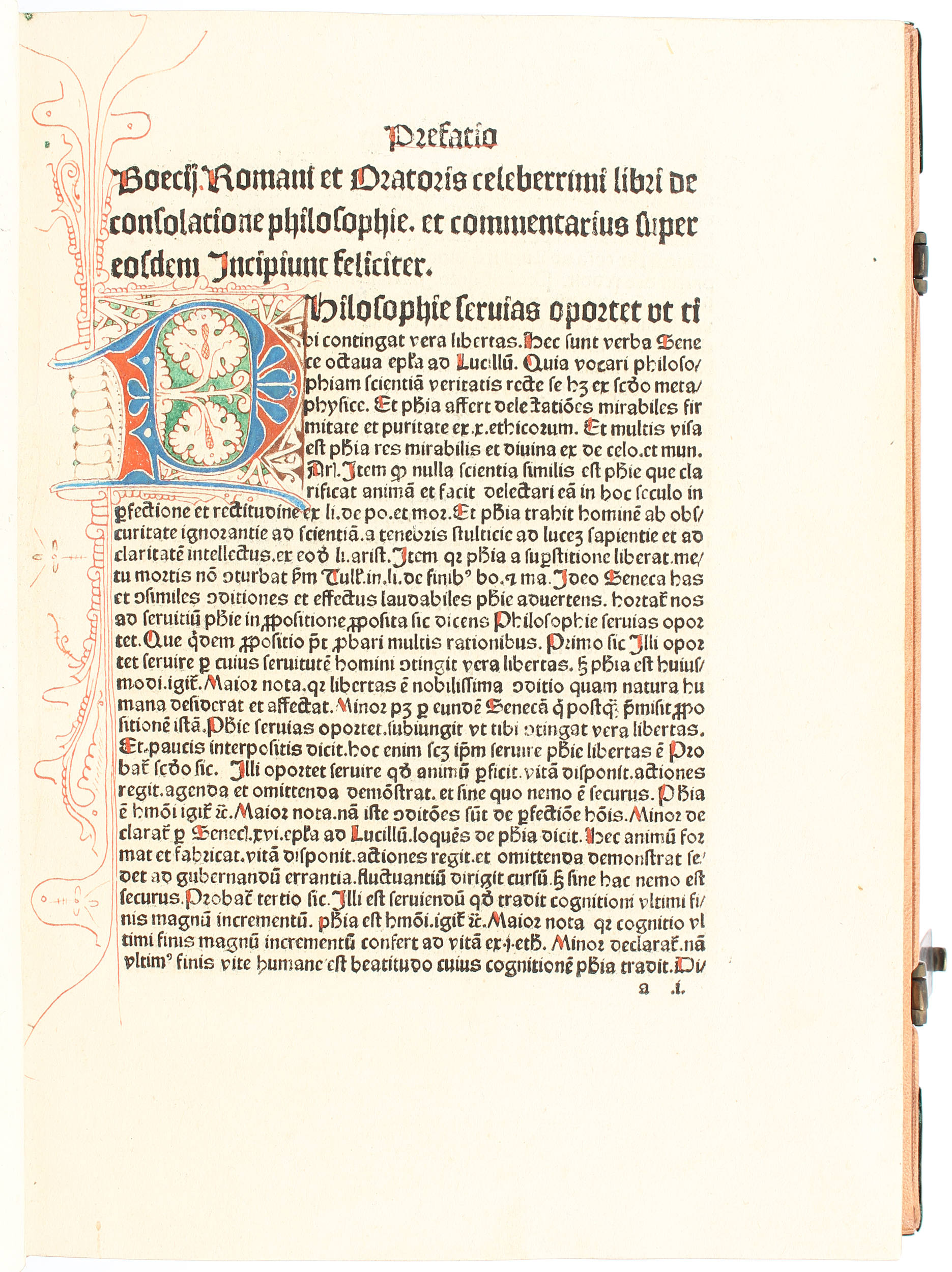BOETHIUS (c. 476-524). De Consolatione Philosophiae , in Latin, DECORATED MANUSCRIPT ON VELLUM [Italy, 14th century] 225 x 154mm. 58 leaves, ii + 1-7 8, COMPLETE, pencil foliation 1-58 followed here, catchwords on final versos of each gathering, guide letters for book numbers in upper outer corners of each recto from f.27 to end, 30 lines written in brown ink in a gothic bookhand between two verticals and 31 horizontals ruled in plummet, justification: 225 x 152mm, rubrics in red, text capitals and first letters of each line of verse touched red, two-line initials alternately red or blue with flourishing of the other colour, the books opening with LARGE 'PUZZLE' INITIALS OF RED AND BLUE WITH RESERVE-PATTERNED INFILLING AND ELABORATE FLOURISHING OF BOTH COLOURS, interlinear annotations, occasional manicoli , further annotations added in cursive on ff.1-2 (some spotting and darkening and a few wormholes to first and last leaves). 19th-century vellum with leather lettering-piece (two corners and lettering-piece somewhat rubbed). PROVENANCE: 1. The style of the decorative initials indicates an origin in northern Italy and the manuscript may have remained there into the fifteenth century when the additions were made concerning the nature of Venice 'quedam ornata civitas' and its doge. 2. Rev. Henry Drury, 1822: his inscription on first endleaf and his sale London 19 February 1827. Drury, a teacher and friend of Byron and a friend of Dibden, had a great contemporary reputation as a classical scholar. His library reflected this interest and included more than 250 medieval manuscripts, many of which were acquired by Sir Thomas Phillipps. Drury was one of the original members of the Roxburghe Club. 3. Acton Griscom, High Point, New Jersey: de Ricci Census , p.1162, no 10. 4. E.W.S 1959: note on first endleaf. 5. Dokter Paul Vertongen: his armorial bookplate inside upper cover. CONTENT: Boethius, De Consolatione Philosophiae , I-V ff.3-57. The central text is preceded by a bifolium with a section of questions and answers on the nature of abstract qualities written on the first recto in a fourteenth-century hand: Quid est anima... Quid est honor.... Quid est pudor until, in a different hand a later insertion, Quid est libido , and thereafter, in a 15th-century hand, Quid est venetie . On the second verso of the bifolium, f.2v, facing the opening of De consolatione , and in the same hand as the earliest text on f.1, a brief life of Boethius opening Boethius iste nobilissimus civis romanus fuit . This is a version of the life of Boethius associated with William of Conches's commentary on the Consolation , the Vita VII in M.T. Gibson and L. Smith, Codices Boethiani, a Conspectus of Manuscripts of the Works of Boethius. I, Great Britain and the Republic of Ireland , London 1995, pp.15-16. Two marginal glosses in the same neat, small script were added to ff.4 and 4v. Comments on Boethius were added on ff.1v-2. The Consolation of Philosophy was written by Boethius during the imprisonment that immediately preceded his death. It takes the form of a dialogue between the author and Lady Philosophy, who comes to console him by reminding him of the suffering of other thinkers, of the vagaries of Fortune and of the vanity of worldy values. The five books are interspersed with 39 short poems and the work is the basis of Boethius' literary reputation. It was widely translated, its translators including Alfred the Great, Chaucer and Elizabeth I, and it provided comfort to readers throughout the Middle Ages. In spite of its importance and popularity the work is not common at auction: this is the first complete copy of the Latin original to have been offered since 1975. It is an unostentatious but handsome and elegantly produced manuscript. Modern editions include Corpus Scriptorum Ecclesiasticorum Latinorum , vol.67 and Corpus Christianorum, Series Latina , vol.94.
BOETHIUS (c. 476-524). De Consolatione Philosophiae , in Latin, DECORATED MANUSCRIPT ON VELLUM [Italy, 14th century] 225 x 154mm. 58 leaves, ii + 1-7 8, COMPLETE, pencil foliation 1-58 followed here, catchwords on final versos of each gathering, guide letters for book numbers in upper outer corners of each recto from f.27 to end, 30 lines written in brown ink in a gothic bookhand between two verticals and 31 horizontals ruled in plummet, justification: 225 x 152mm, rubrics in red, text capitals and first letters of each line of verse touched red, two-line initials alternately red or blue with flourishing of the other colour, the books opening with LARGE 'PUZZLE' INITIALS OF RED AND BLUE WITH RESERVE-PATTERNED INFILLING AND ELABORATE FLOURISHING OF BOTH COLOURS, interlinear annotations, occasional manicoli , further annotations added in cursive on ff.1-2 (some spotting and darkening and a few wormholes to first and last leaves). 19th-century vellum with leather lettering-piece (two corners and lettering-piece somewhat rubbed). PROVENANCE: 1. The style of the decorative initials indicates an origin in northern Italy and the manuscript may have remained there into the fifteenth century when the additions were made concerning the nature of Venice 'quedam ornata civitas' and its doge. 2. Rev. Henry Drury, 1822: his inscription on first endleaf and his sale London 19 February 1827. Drury, a teacher and friend of Byron and a friend of Dibden, had a great contemporary reputation as a classical scholar. His library reflected this interest and included more than 250 medieval manuscripts, many of which were acquired by Sir Thomas Phillipps. Drury was one of the original members of the Roxburghe Club. 3. Acton Griscom, High Point, New Jersey: de Ricci Census , p.1162, no 10. 4. E.W.S 1959: note on first endleaf. 5. Dokter Paul Vertongen: his armorial bookplate inside upper cover. CONTENT: Boethius, De Consolatione Philosophiae , I-V ff.3-57. The central text is preceded by a bifolium with a section of questions and answers on the nature of abstract qualities written on the first recto in a fourteenth-century hand: Quid est anima... Quid est honor.... Quid est pudor until, in a different hand a later insertion, Quid est libido , and thereafter, in a 15th-century hand, Quid est venetie . On the second verso of the bifolium, f.2v, facing the opening of De consolatione , and in the same hand as the earliest text on f.1, a brief life of Boethius opening Boethius iste nobilissimus civis romanus fuit . This is a version of the life of Boethius associated with William of Conches's commentary on the Consolation , the Vita VII in M.T. Gibson and L. Smith, Codices Boethiani, a Conspectus of Manuscripts of the Works of Boethius. I, Great Britain and the Republic of Ireland , London 1995, pp.15-16. Two marginal glosses in the same neat, small script were added to ff.4 and 4v. Comments on Boethius were added on ff.1v-2. The Consolation of Philosophy was written by Boethius during the imprisonment that immediately preceded his death. It takes the form of a dialogue between the author and Lady Philosophy, who comes to console him by reminding him of the suffering of other thinkers, of the vagaries of Fortune and of the vanity of worldy values. The five books are interspersed with 39 short poems and the work is the basis of Boethius' literary reputation. It was widely translated, its translators including Alfred the Great, Chaucer and Elizabeth I, and it provided comfort to readers throughout the Middle Ages. In spite of its importance and popularity the work is not common at auction: this is the first complete copy of the Latin original to have been offered since 1975. It is an unostentatious but handsome and elegantly produced manuscript. Modern editions include Corpus Scriptorum Ecclesiasticorum Latinorum , vol.67 and Corpus Christianorum, Series Latina , vol.94.
.jpg)
.jpg)



.jpg?w=400)









Try LotSearch and its premium features for 7 days - without any costs!
Be notified automatically about new items in upcoming auctions.
Create an alert